AIDS TODAY(江苏省盐城市东台市)
文档属性
| 名称 | AIDS TODAY(江苏省盐城市东台市) | 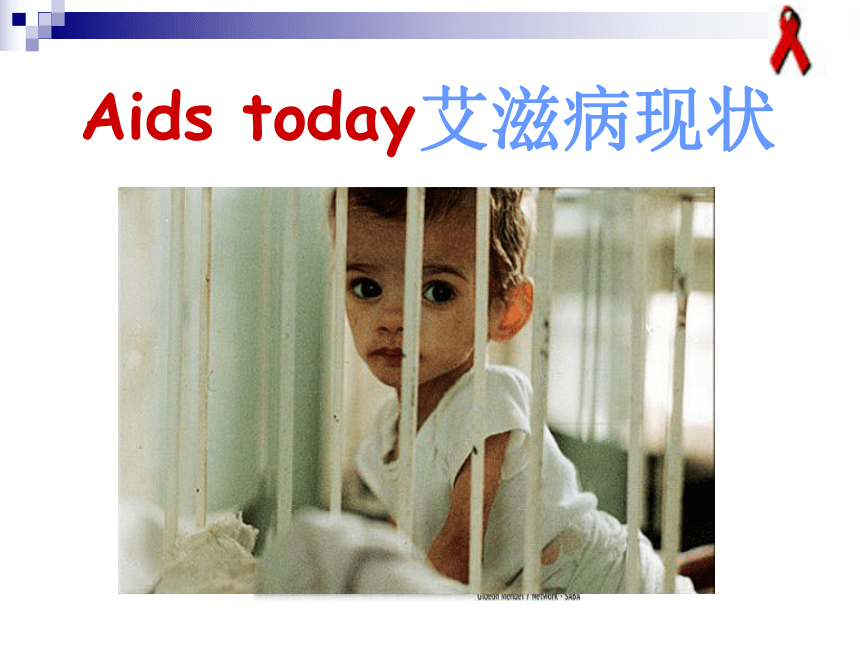 | |
| 格式 | rar | ||
| 文件大小 | 387.2KB | ||
| 资源类型 | 教案 | ||
| 版本资源 | 牛津译林版 | ||
| 科目 | 英语 | ||
| 更新时间 | 2007-11-28 16:21:00 | ||
图片预览

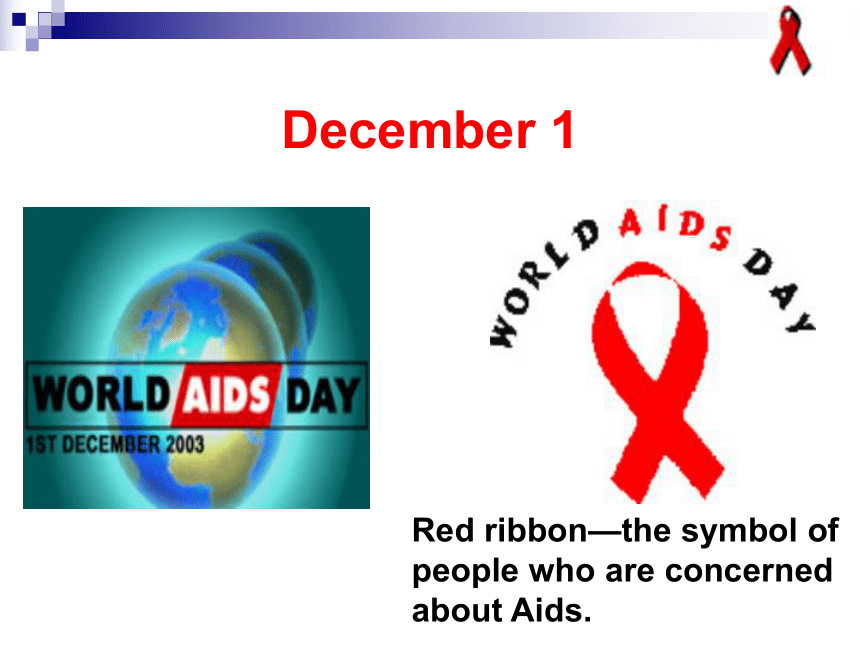

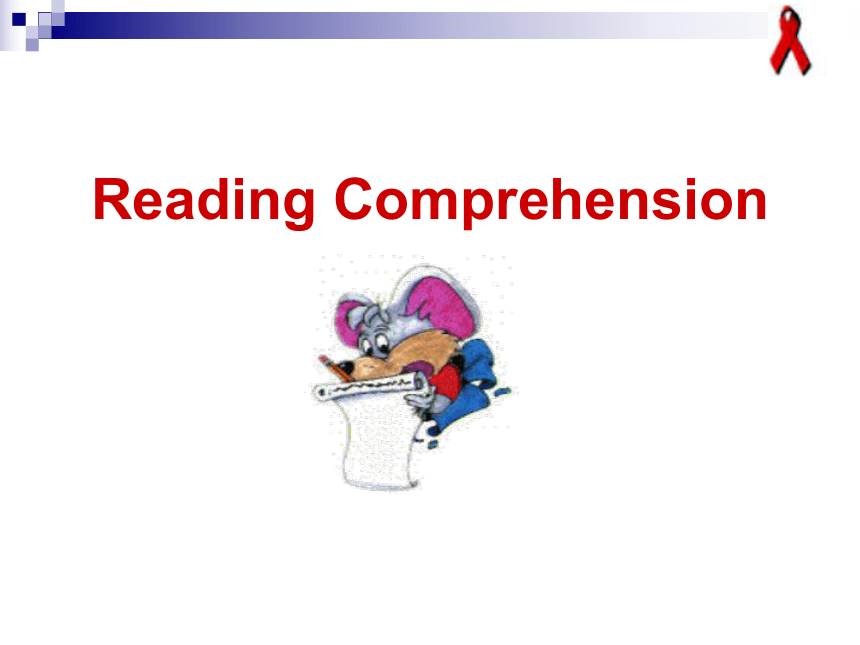
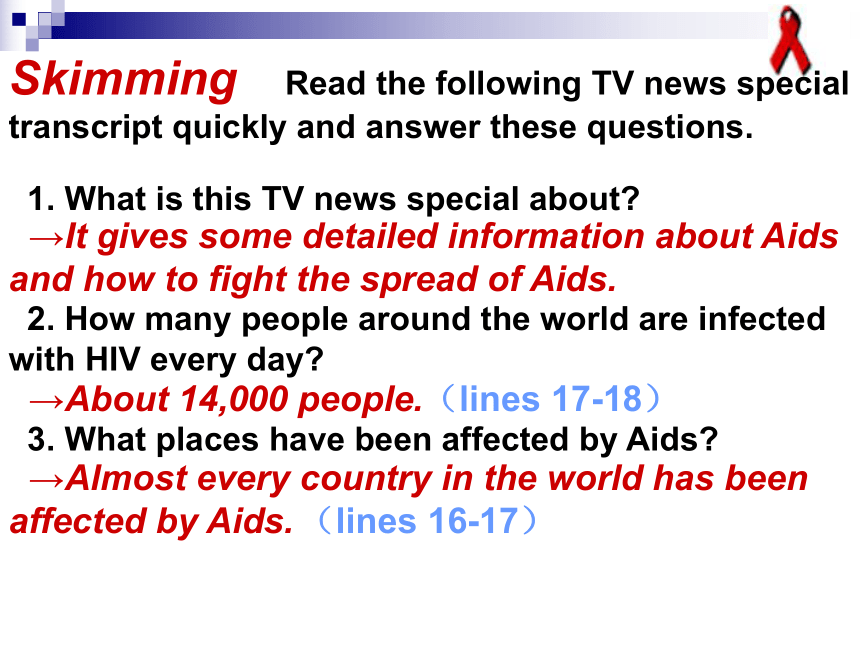
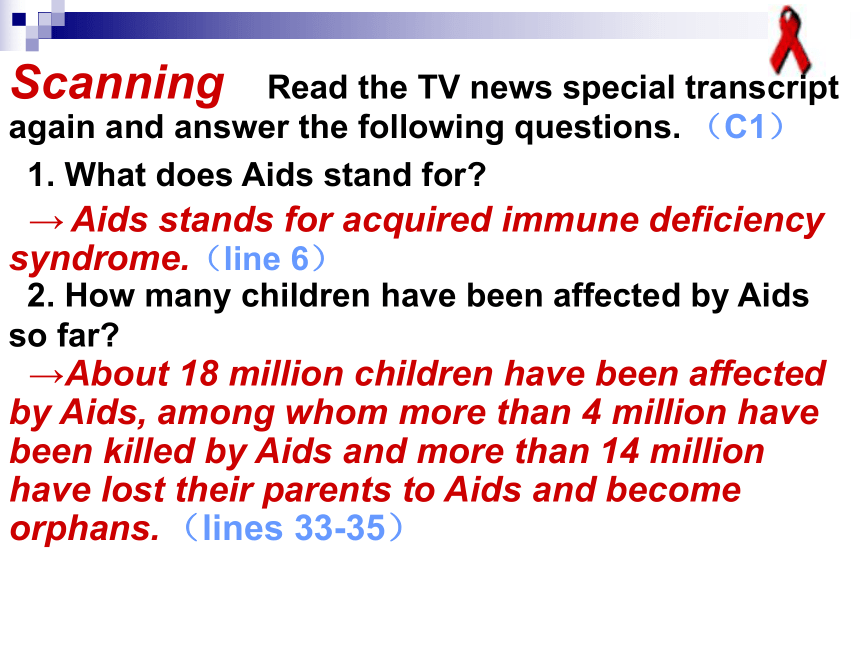



文档简介
课件28张PPT。Aids today 艾滋病现状December 1 Red ribbon—the symbol of people who are concerned about Aids.( ) 1 Is HIV a virus?
( ) 2 Is there a cure for AIDS?
( ) 3 Can mosquitoes or other insects transmit HIV?
( ) 4 Can you get AIDS from sharing a cup with an
infected person?
( ) 5 Is it safe to be friends with those who are
living with HIV/AIDS?
Which part of the world has the largest number of people who are HIV positive?Pre-reading How much do you know about Aids?YesNoNoNoYes →Africa.Reading ComprehensionSkimming Read the following TV news special transcript quickly and answer these questions. 1. What is this TV news special about?
2. How many people around the world are infected with HIV every day?
3. What places have been affected by Aids? →It gives some detailed information about Aids and how to fight the spread of Aids. →About 14,000 people.(lines 17-18) →Almost every country in the world has been affected by Aids. (lines 16-17)Scanning Read the TV news special transcript again and answer the following questions. (C1) 1. What does Aids stand for?
2. How many children have been affected by Aids so far? → Aids stands for acquired immune deficiency syndrome.(line 6) →About 18 million children have been affected by Aids, among whom more than 4 million have been killed by Aids and more than 14 million have lost their parents to Aids and become orphans. (lines 33-35) 3. How does HIV affect the body?
4. What are the three ways Aids is transmitted? →HIV is a virus that enters a person’s blood and attacks the body’s immune system, so the immune system is weakened, and then it gradually loses the ability to fight illnesses. Eventually the body’s immune system becomes so weak that the person becomes sick very easily.(lines 6-8, lines 13-15) →The three ways are unprotected sex, blood-to-blood contact and mother-to-child transmission.
(lines 19-20) 5. What is being done in China to help control the Aids epidemic?
6. What is the aim of UNAIDS? →China is working hard to control the epidemic, and has opened HIV/Aids labs to test and moni-tor the disease across the country. In 2003, the government started providing free Aids drugs for Aids patients in need.(lines 39-42) →The aim of UNAIDS is to help prevent the spread of Aids.(lines 50-51) 7. What does UNAIDS do for people who think they might have the virus?
8. Why did Ajani not catch the virus from his mother? →It provides infected people with help from doctors and testing for people who think they might have HIV or Aids.(lines 51-54) →Because his mother had access to prescrip-tions during pregnancy.(lines 65-66) Do you know the figures concerning Aids?
Match each item below with the correct number. Write the correct letters in brackets.
a. >60 million b. 75,000 c. >4 million d. about 14,000
e. 650,000 f. >68 million g. >14 million
( ) 1. the number of children who have lost their
parents to Aids
( ) 2. the number of HIV carriers in China
( ) 3. the number of people infected with Aids since
the 1980s
( ) 4. the number of people who will die of Aids be-
tween 2000 and 2020
( ) 5. the number of Aids patients in China
( ) 6. the number of people being infected with Aids
per day
( ) 7. the number of children killed by AidsgeafbdcFurther reading Choose the right answer.
1. What causes Aids?
A. The virus of malaria.
B. A virus called HIV.
C. Certain vaccination.
D. Bacteria.
2. What is one of the symptoms that most HIV-
positive people have?
A. A weakened immune system.
B. The reducing of white blood cells.
C. The infected one can’t eat anything.
D. The infected one may often feel faint.3. In Ajani’s opinion, what’s the key to stopping Aids?
A. The government should take some measures.
B. The UN should call on people to resist Aids.
C. Educating people at risk and treating the
infected ones.
D. They must earn more money to treat the
disease.
4. What is UNAIDS?
A. An organization set up by some African
countries.
B. An organization to help the poor.
C. An organization within the UN.
D. An organization to assist the African. 5. Who has helped China to fight Aids?
A. The WHO. B. Dr. David Ho.
C. Ajani. D. The USA.
6. What did the Chinese government do in 2003?
A. They opened labs to test and monitor the
disease.
B. They were working hard to control the Aids
epidemic.
C. They fought against Aids bravely and actively.
D. They began to supply free drugs to Aids pa-
tients who need them.Structure analysisPart 1:
Part 2:
Part 3:Paragraph 1 the introductionParagraph 2-9 the main bodyParagraph 10 the conclusiona virus called HIVenters a person’s blood and attacks the body’s immune system is a weakened immune system it loses the ability to fight
illnesses the immune system be-comes so weak that the infected person can be- come sick easily, and even common illnesses like the flu can be quite serious across the world at a frightening rateunprotected sexblood-to-blood contact mother-to-child
transmission Argentina
to the Netherlands, the Philippines and every-
where in between the
disease has become a serious problem in many
places, infecting over 60 million people more than 4 million chil-
dren had died from Aids, and more than 14 mil-
lion children had lost their parents to Aids□ affect vt. 影响;感动;(疾病)侵袭
effect n. 效果;作用 vt. 引起,产生
Does the amount of rain affect the growth of crops?
降水量会影响作物的生长吗?
All the people in the room were affected to tears.
屋里所有的人都被感动得流泪了。
This disease affects millions in the world every
year. 这种病每年都使世界上成千上万的人受到感染。
● have no/little, some, much, a bad (ill) effect
没有影响,几乎没有影响,有些影响,影响很大,有不良影响
● put/carry, bring sth. into effect 实行,实施
● come into effect/enter into effect 生效,实施
● in effect 事实上,在实施中,有效
● be of no effect 无效,无用□ access n. (向场所等)接近,进入;接近(或进入)
的方法;到达(或进入、使用、走访)的权利
(或机会);通道,门路(常与to连用)
We gained access to the house through the window.
Every student has free access to the library.
Fallen rocks cut off the only access to the village.
☆提示:access前通常不加冠词。
a place easy/difficult of access 易于/难以进入的地方
get access to sb. 接近某人,遇到某人
have no access to education 没有受教育的机会
give access to 使能接近…
The living people in these apartments have free ___
to that swimming pool.
A. time B. entrance C. charge D. accessLanguage focus 1. 远方的一声尖叫
2. 等待妈妈回来
3. 死于同样的疾病
4. 由……引起
5. 一种称为HIV的病毒
6. 治疗……的方法
7. 外部症状
8. 变弱的免疫系统
9. 抵御疾病的能力
10. 被感染的人
11. 以令人恐怖的速度
12. 占,占据;解释,说明 a far-off screamwait for one’s mother to returndie of the same diseasebe caused by…a virus called HIVa cure for…outward symptomsa weakened immune systemthe ability to fight illnessesthe infected personat a frightening rateaccount for13. 冒着健康的危险
14. (人)熟悉……
15. 同意,赞成;订阅
16. 其他任何地方
17. 在20世纪80年代
18. 死于艾滋病
19. 由于艾滋病 失去父母
20. 受……影响
21. 努力工作以……
22. 为……提供免费药物
23. 除……之外
24. 全身心投入到……
25. 使关注到……
26. 参与;涉及;专心risk one’s healthbe familiar with…subscribe toeverywhere in betweenin the 1980s/1980’sdie from Aidslose one’s parents to Aidsbe affected by…work hard to…provide free drugs for…apart from…/in addition to …devote one’s body and soul tobring attention to…be involved in…27. 防止……的传播
28. 医生的帮助
29. 建立医疗中心
30. 预计会增加
31. 给……留下伤痕
32. 接近
33. 处境危险的人
34. 是……的关健
35. 控制住,忍住
36. 有影响,很重要prevent the spread of…help from doctorsset up treatment centresbe expected to riseleave a scar on…have access to…people at riskbe the key to…choke back make a difference Sentence patterns 1. HIV and Aids are spreading across the world at a frightening rate, with about 14,000 people being infected daily. (lines 17-18)
2. Unprotected sex is the most common way that the virus is spread, accounting for 75 percent of adult infections worldwide. (lines 20-21) 3. Although many people are familiar with Aids and how it is transmitted, more than a few people subscribe to the view that HIV and Aids are an African problem because the infection rates there are very high.(lines 26-28)
4. Since the disease was discovered in the 1980s, it has become a serious problem in many places, infecting over 60 million people worldwide.(lines 30-32)Life is like a moon,
sometimes round,
sometimes not.
We have happy times
and also sad moments.
If we draw a timeline,
we will find it
is not always straight. 假如你是记者李华,当你得知小华的病情和现状,决定就此事写一篇报道,帮助人们正确认识艾滋病,号召更多的人关爱他人。
要求:包括以下要点,字数120左右。
1. 艾滋病是通过血液或其他体液传播的,它破坏人的免疫系统,使人失去抵抗力。
2. 每天成千上万的儿童感染艾滋病,尤其在非洲和亚洲部分地区,主要是因为缺乏健康知识,预防措施和教育。
3.艾滋病病人不仅要忍受病痛,还要面对人们的恐惧。
4. 我们应该关爱他们,帮助他们,鼓励他们珍惜生命。Thank youIt is said that a falling star can make your dream come true. If you saw a falling star, what wishes would you make? The development of a text A text should be written in the way that allows readers to move from one idea to the next easily. For a text to develop logically, we should include the following.1 A titleAids today2 A beginning paragrapha topic sentencea hook In an Africa village, eleven-year-old Ajani hears a far-off scream as he washes his little sister in a bath that leaks water.3 Body paragraphsTopic sentenceSupporting sentenceConcluding sentence Aids (…) is caused by a virus called HIV(…), which enters a person’s blood and attacks the body’s immune system. As the immune system weakens, it loses the ability to fight illnesses. Sometimes, infected people have no outward symptoms, so they do not know that they are carriers.(concluding sentence of the next paragraph) (One of the first symptoms…(first sentence of the next paragraph)4 A concluding paragraph1 a final topic statement2 the example mentioned
in the beginning para-
graph Although Aids has left a scar on Ajani and his sister, they are lucky. Their grandfather is taking care of them, and because their mother had access to prescription Aids medications during pregnancy, they did not get HIV from her..Workbook(Page 116 C1)The letter of the topic for each paragraph: b, c, aWorkbook(Page 116 C2)→edcab
( ) 2 Is there a cure for AIDS?
( ) 3 Can mosquitoes or other insects transmit HIV?
( ) 4 Can you get AIDS from sharing a cup with an
infected person?
( ) 5 Is it safe to be friends with those who are
living with HIV/AIDS?
Which part of the world has the largest number of people who are HIV positive?Pre-reading How much do you know about Aids?YesNoNoNoYes →Africa.Reading ComprehensionSkimming Read the following TV news special transcript quickly and answer these questions. 1. What is this TV news special about?
2. How many people around the world are infected with HIV every day?
3. What places have been affected by Aids? →It gives some detailed information about Aids and how to fight the spread of Aids. →About 14,000 people.(lines 17-18) →Almost every country in the world has been affected by Aids. (lines 16-17)Scanning Read the TV news special transcript again and answer the following questions. (C1) 1. What does Aids stand for?
2. How many children have been affected by Aids so far? → Aids stands for acquired immune deficiency syndrome.(line 6) →About 18 million children have been affected by Aids, among whom more than 4 million have been killed by Aids and more than 14 million have lost their parents to Aids and become orphans. (lines 33-35) 3. How does HIV affect the body?
4. What are the three ways Aids is transmitted? →HIV is a virus that enters a person’s blood and attacks the body’s immune system, so the immune system is weakened, and then it gradually loses the ability to fight illnesses. Eventually the body’s immune system becomes so weak that the person becomes sick very easily.(lines 6-8, lines 13-15) →The three ways are unprotected sex, blood-to-blood contact and mother-to-child transmission.
(lines 19-20) 5. What is being done in China to help control the Aids epidemic?
6. What is the aim of UNAIDS? →China is working hard to control the epidemic, and has opened HIV/Aids labs to test and moni-tor the disease across the country. In 2003, the government started providing free Aids drugs for Aids patients in need.(lines 39-42) →The aim of UNAIDS is to help prevent the spread of Aids.(lines 50-51) 7. What does UNAIDS do for people who think they might have the virus?
8. Why did Ajani not catch the virus from his mother? →It provides infected people with help from doctors and testing for people who think they might have HIV or Aids.(lines 51-54) →Because his mother had access to prescrip-tions during pregnancy.(lines 65-66) Do you know the figures concerning Aids?
Match each item below with the correct number. Write the correct letters in brackets.
a. >60 million b. 75,000 c. >4 million d. about 14,000
e. 650,000 f. >68 million g. >14 million
( ) 1. the number of children who have lost their
parents to Aids
( ) 2. the number of HIV carriers in China
( ) 3. the number of people infected with Aids since
the 1980s
( ) 4. the number of people who will die of Aids be-
tween 2000 and 2020
( ) 5. the number of Aids patients in China
( ) 6. the number of people being infected with Aids
per day
( ) 7. the number of children killed by AidsgeafbdcFurther reading Choose the right answer.
1. What causes Aids?
A. The virus of malaria.
B. A virus called HIV.
C. Certain vaccination.
D. Bacteria.
2. What is one of the symptoms that most HIV-
positive people have?
A. A weakened immune system.
B. The reducing of white blood cells.
C. The infected one can’t eat anything.
D. The infected one may often feel faint.3. In Ajani’s opinion, what’s the key to stopping Aids?
A. The government should take some measures.
B. The UN should call on people to resist Aids.
C. Educating people at risk and treating the
infected ones.
D. They must earn more money to treat the
disease.
4. What is UNAIDS?
A. An organization set up by some African
countries.
B. An organization to help the poor.
C. An organization within the UN.
D. An organization to assist the African. 5. Who has helped China to fight Aids?
A. The WHO. B. Dr. David Ho.
C. Ajani. D. The USA.
6. What did the Chinese government do in 2003?
A. They opened labs to test and monitor the
disease.
B. They were working hard to control the Aids
epidemic.
C. They fought against Aids bravely and actively.
D. They began to supply free drugs to Aids pa-
tients who need them.Structure analysisPart 1:
Part 2:
Part 3:Paragraph 1 the introductionParagraph 2-9 the main bodyParagraph 10 the conclusiona virus called HIVenters a person’s blood and attacks the body’s immune system is a weakened immune system it loses the ability to fight
illnesses the immune system be-comes so weak that the infected person can be- come sick easily, and even common illnesses like the flu can be quite serious across the world at a frightening rateunprotected sexblood-to-blood contact mother-to-child
transmission Argentina
to the Netherlands, the Philippines and every-
where in between the
disease has become a serious problem in many
places, infecting over 60 million people more than 4 million chil-
dren had died from Aids, and more than 14 mil-
lion children had lost their parents to Aids□ affect vt. 影响;感动;(疾病)侵袭
effect n. 效果;作用 vt. 引起,产生
Does the amount of rain affect the growth of crops?
降水量会影响作物的生长吗?
All the people in the room were affected to tears.
屋里所有的人都被感动得流泪了。
This disease affects millions in the world every
year. 这种病每年都使世界上成千上万的人受到感染。
● have no/little, some, much, a bad (ill) effect
没有影响,几乎没有影响,有些影响,影响很大,有不良影响
● put/carry, bring sth. into effect 实行,实施
● come into effect/enter into effect 生效,实施
● in effect 事实上,在实施中,有效
● be of no effect 无效,无用□ access n. (向场所等)接近,进入;接近(或进入)
的方法;到达(或进入、使用、走访)的权利
(或机会);通道,门路(常与to连用)
We gained access to the house through the window.
Every student has free access to the library.
Fallen rocks cut off the only access to the village.
☆提示:access前通常不加冠词。
a place easy/difficult of access 易于/难以进入的地方
get access to sb. 接近某人,遇到某人
have no access to education 没有受教育的机会
give access to 使能接近…
The living people in these apartments have free ___
to that swimming pool.
A. time B. entrance C. charge D. accessLanguage focus 1. 远方的一声尖叫
2. 等待妈妈回来
3. 死于同样的疾病
4. 由……引起
5. 一种称为HIV的病毒
6. 治疗……的方法
7. 外部症状
8. 变弱的免疫系统
9. 抵御疾病的能力
10. 被感染的人
11. 以令人恐怖的速度
12. 占,占据;解释,说明 a far-off screamwait for one’s mother to returndie of the same diseasebe caused by…a virus called HIVa cure for…outward symptomsa weakened immune systemthe ability to fight illnessesthe infected personat a frightening rateaccount for13. 冒着健康的危险
14. (人)熟悉……
15. 同意,赞成;订阅
16. 其他任何地方
17. 在20世纪80年代
18. 死于艾滋病
19. 由于艾滋病 失去父母
20. 受……影响
21. 努力工作以……
22. 为……提供免费药物
23. 除……之外
24. 全身心投入到……
25. 使关注到……
26. 参与;涉及;专心risk one’s healthbe familiar with…subscribe toeverywhere in betweenin the 1980s/1980’sdie from Aidslose one’s parents to Aidsbe affected by…work hard to…provide free drugs for…apart from…/in addition to …devote one’s body and soul tobring attention to…be involved in…27. 防止……的传播
28. 医生的帮助
29. 建立医疗中心
30. 预计会增加
31. 给……留下伤痕
32. 接近
33. 处境危险的人
34. 是……的关健
35. 控制住,忍住
36. 有影响,很重要prevent the spread of…help from doctorsset up treatment centresbe expected to riseleave a scar on…have access to…people at riskbe the key to…choke back make a difference Sentence patterns 1. HIV and Aids are spreading across the world at a frightening rate, with about 14,000 people being infected daily. (lines 17-18)
2. Unprotected sex is the most common way that the virus is spread, accounting for 75 percent of adult infections worldwide. (lines 20-21) 3. Although many people are familiar with Aids and how it is transmitted, more than a few people subscribe to the view that HIV and Aids are an African problem because the infection rates there are very high.(lines 26-28)
4. Since the disease was discovered in the 1980s, it has become a serious problem in many places, infecting over 60 million people worldwide.(lines 30-32)Life is like a moon,
sometimes round,
sometimes not.
We have happy times
and also sad moments.
If we draw a timeline,
we will find it
is not always straight. 假如你是记者李华,当你得知小华的病情和现状,决定就此事写一篇报道,帮助人们正确认识艾滋病,号召更多的人关爱他人。
要求:包括以下要点,字数120左右。
1. 艾滋病是通过血液或其他体液传播的,它破坏人的免疫系统,使人失去抵抗力。
2. 每天成千上万的儿童感染艾滋病,尤其在非洲和亚洲部分地区,主要是因为缺乏健康知识,预防措施和教育。
3.艾滋病病人不仅要忍受病痛,还要面对人们的恐惧。
4. 我们应该关爱他们,帮助他们,鼓励他们珍惜生命。Thank youIt is said that a falling star can make your dream come true. If you saw a falling star, what wishes would you make? The development of a text A text should be written in the way that allows readers to move from one idea to the next easily. For a text to develop logically, we should include the following.1 A titleAids today2 A beginning paragrapha topic sentencea hook In an Africa village, eleven-year-old Ajani hears a far-off scream as he washes his little sister in a bath that leaks water.3 Body paragraphsTopic sentenceSupporting sentenceConcluding sentence Aids (…) is caused by a virus called HIV(…), which enters a person’s blood and attacks the body’s immune system. As the immune system weakens, it loses the ability to fight illnesses. Sometimes, infected people have no outward symptoms, so they do not know that they are carriers.(concluding sentence of the next paragraph) (One of the first symptoms…(first sentence of the next paragraph)4 A concluding paragraph1 a final topic statement2 the example mentioned
in the beginning para-
graph Although Aids has left a scar on Ajani and his sister, they are lucky. Their grandfather is taking care of them, and because their mother had access to prescription Aids medications during pregnancy, they did not get HIV from her..Workbook(Page 116 C1)The letter of the topic for each paragraph: b, c, aWorkbook(Page 116 C2)→edcab
同课章节目录
- 模块9
- Unit 1 Other countries, other cultures
- Unit 2 Witnessing time
- Unit 3 The meaning of colou
- Unit 4 Behind beliefs
- 模块10
- unit 1 building the future
- unit 2 people on the move
- unit 3 protecting ourselves
- unit 4 law and orde
- 模块11
- unit 1 careers and skills
- unit 2 getting a job
- unit 3 the secret of success
- unit 4 the next step
